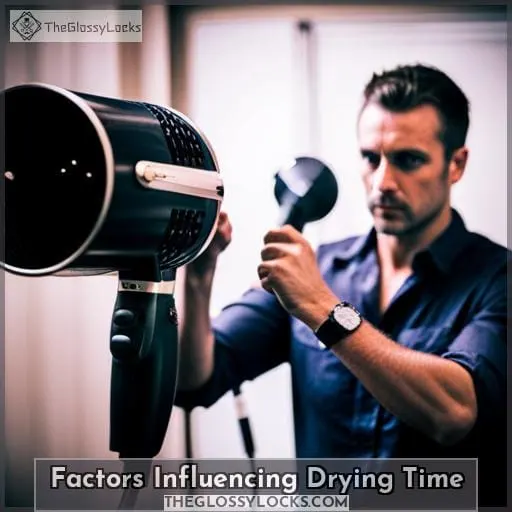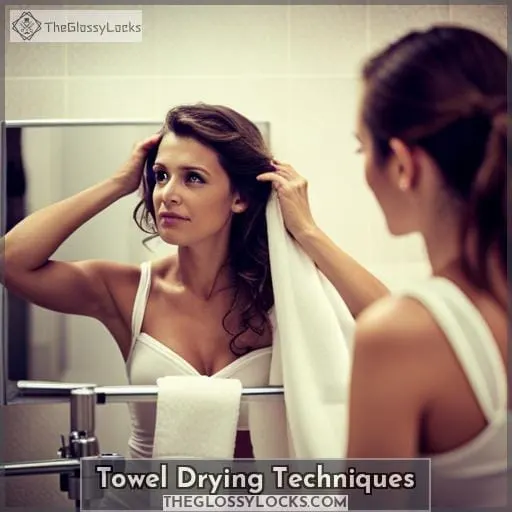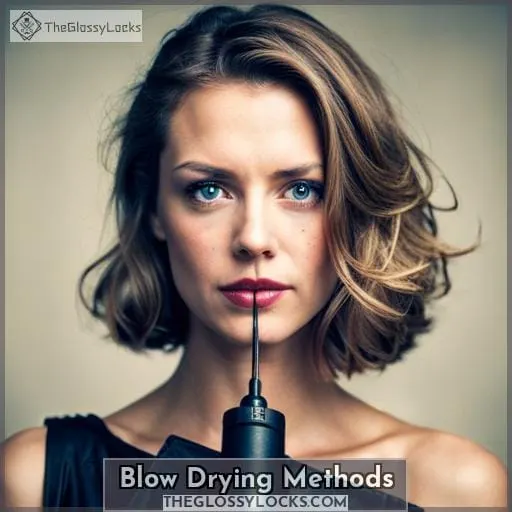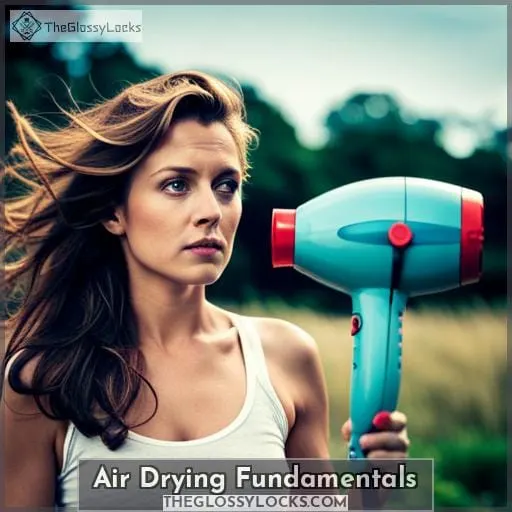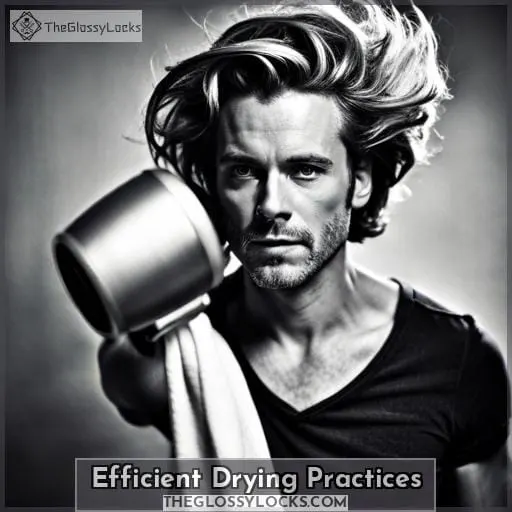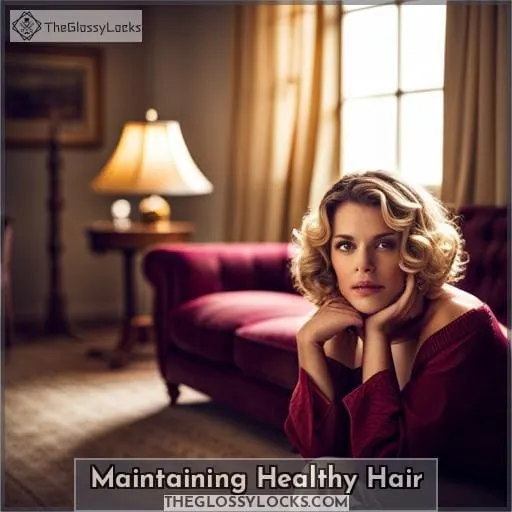This site is supported by our readers. We may earn a commission, at no cost to you, if you purchase through links.
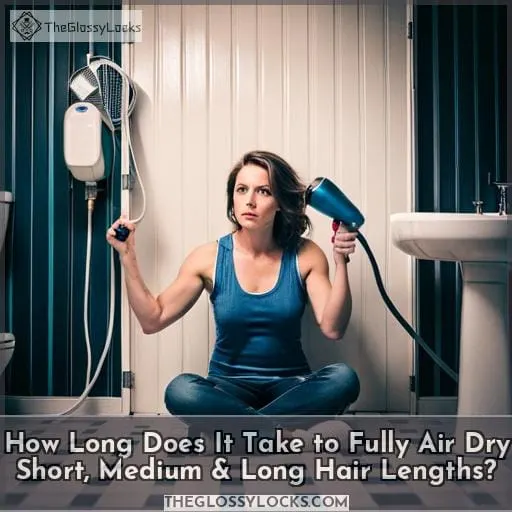
Discover the factors that influence drying time, from hair type to length and the method you use.
Get practical tips on towel drying techniques, blow-drying methods, and efficient air drying practices.
Learn how to prevent heat damage and maintain healthy hair while achieving quick and effective results.
Gain liberation over your hairstyling routine by mastering these essential techniques for short, medium, and long lengths of hair.
Table Of Contents
- Key Takeaways
- Factors Influencing Drying Time
- Towel Drying Techniques
- Blow Drying Methods
- Air Drying Fundamentals
- Efficient Drying Practices
- Preventing Heat Damage
- Maintaining Healthy Hair
- Troubleshooting Common Issues
- Frequently Asked Questions (FAQs)
- How often should I wash my hair when air drying? Washing hair too frequently, especially when air drying, can lead to dryness and damage.
- What kind of brush should I use when blow drying? Using a round brush when blow drying can help create volume and bend the hair into shape. Paddle brushes work better for straightening.
- How can I get my hair to dry faster overnight? Sleeping on a silk pillowcase or tying hair in a loose bun on top of your head allows more air circulation and faster drying.
- What causes frizzy hair when air drying? Lack of moisture is the main culprit behind frizzy air dried hair. Using leave-in conditioner and avoiding towel rubbing reduces frizz.
- Why does the back of my hair take longer to dry? The back of the head doesn’t get as much air circulation. Sectioning hair in clips helps expose all areas evenly for uniform drying.
- Conclusion
Key Takeaways
- Factors such as hair type, length, drying method, and the use of a microfiber towel or t-shirt plopping can influence drying time.
- Towel drying techniques include gently wringing the hair, blotting in sections, and allowing it to air-dry up to 70 percent before heat styling.
- Blow drying methods involve using a quality blow dryer with a diffuser attachment, using a round brush for straight strands, and always using a heat protectant.
- Air drying fundamentals include allowing the hair to dry up to 70 percent, using conditioners with silicones, and sectioning the hair in clips for even drying.
Factors Influencing Drying Time
When determining how long it takes for your hair to fully air dry, there are three key factors to consider:
- Hair type
- Hair length
- Drying method
These elements directly impact the duration, with certain hair types and lengths taking longer, and some drying techniques expediating the process more effectively. As we examine typical air drying times for varying hair lengths, keep these influencing elements in mind.
Hair Type
Since the thickness and texture of your hair impacts how quickly it can dry, hair type is a key factor that determines the time needed to fully air dry short, medium, and long hair lengths.
Here are five factors related to hair type that affect drying time:
- Fine Hair: Dries faster due to its thin strands.
- Thick Hair: Takes longer as it holds more moisture.
- Curly Hair: Requires additional drying time because of its natural shape.
- Straight Hair: Dries relatively quickly due to its smooth texture.
- Wavy Hair: Falls somewhere in between straight and curly in terms of drying speed.
Hair Length
To determine how long it takes to fully air dry your hair, the next factor to consider is your hair length and its influence on drying time.
Long hair can take up to 45 minutes to air dry from wet to 50 percent dry, whereas short hair may only take 15 minutes.
Consider your specific hair length, texture, and density when estimating total drying time. Thicker, curlier long hair retains more water and requires more time to dry than fine, straight short hair.
Drying Method
Your drying method directly impacts the time it’ll take to fully air dry your hair.
- Microfiber towel or t-shirt plopping: Using a microfiber towel or a cotton t-shirt can absorb more water from your hair, speeding up the drying process.
- Conditioner assistance: Applying conditioner with silicones can make your hair water-repellent, helping it dry faster.
- 70 percent air-dry: Allowing your hair to air-dry up to about 70 percent before using a blow dryer reduces overall drying time and potential heat damage.
By incorporating these techniques into your routine, you can achieve quicker and healthier results when letting your hair naturally air dry.
Towel Drying Techniques
Although towel drying helps remove excess moisture, you should wring hair gently and avoid rubbing it aggressively to prevent potential breakage or frizz.
After washing, use a microfiber towel or soft t-shirt to blot hair in sections, absorbing moisture without friction.
Allow hair to air-dry to about 70 percent before heat styling.
Conditioner coats strands, repelling water for faster drying.
Mousse boosts volume, aids air-drying, and prevents frizz.
Alternate gentle brush strokes while blow-drying for even heat distribution.
Care for hair properly while maximizing efficiency.
Understand how to balance your preferred styles with mindful protection using the right techniques and quality products.
Confidently achieve salon-worthy results at home through dedicated practice.
Blow Drying Methods
Before we explore the details of blow drying techniques, let’s briefly discuss the tools you’ll need and methods for different hair types.
Having the right hair dryer, nozzle, brushes, and products will ensure efficient drying tailored to your hair’s needs.
We’ll overview techniques for straight, curly, long, and short hair so you can achieve a salon-worthy blowout at home.
Tools Needed
Now let’s dive into the tools you’ll need to achieve a perfect blowout for different hair types.
Invest in a quality blow dryer and diffuser attachment for defining curls, as well as a round brush to smooth straight strands.
Always prep hair with a heat protectant before drying and have sectioning clips, a wide tooth comb, and a microfiber towel on hand.
Using the proper tools tailored to your hair’s needs will ensure a salon-worthy blowout.
Techniques for Different Hair Types
On to blow drying techniques tailored for your hair’s unique texture, including steps for getting beautiful results whether you have straight, curly, or wavy locks.
For curls, use a diffuser on low heat to enhance shape and volume.
Cold air sets straight styles sleekly.
And keep waves bouncy with medium heat—letting hair slightly air dry first prevents frizz.
Sectioning hair helps concentrate the airflow.
Air Drying Fundamentals
To master the art of air drying, understanding the fundamentals is crucial.
When it comes to towel drying, using a microfiber towel or even a cotton t-shirt can help absorb excess water without causing damage or frizz.
Another technique called t-shirt plopping involves wrapping your hair in a t-shirt for additional moisture removal.
Additionally, you can speed up the air-drying process by allowing your hair to dry up to seventy percent before using any heat tools.
Using conditioners with silicones can make your hair more water-repellent and facilitate faster drying as well.
By incorporating these techniques and products into your routine, you’ll be able to achieve faster and more efficient air-drying results while maintaining healthier-looking locks.
Efficient Drying Practices
To efficiently dry your hair, consider sectioning it into smaller parts before blow-drying.
This allows for more thorough drying and styling.
Additionally, using products such as heat protectant sprays or mousse can help speed up the drying process and prevent frizz.
Sectioning Hair
One key step you’re taking for efficient air drying is sectioning your hair into manageable parts before allowing it to fully dry.
How many sections you should use depends on your hair length and thickness. For shoulder length hair, aim for 3-5 sections. Longer or thicker hair may require 8-10 sections for optimal air flow and drying.
Work in horizontal sections across your head or vertical sections from root to tip. Ensure sections are clean and neat to prevent tangles or knots as your hair dries.
Using Products
You’ll also want to use products that help facilitate efficient drying practices.
- Apply a heat protectant before blow drying to reduce potential damage from the heat.
- Mousse can help seal hair cuticles to lock in moisture as you style.
- When air drying, use a diffuser attachment to enhance natural volume or try finishing with a shine spray to add luminosity.
Incorporating targeted products while drying creates a protective barrier and cuts down on overall time.
Preventing Heat Damage
Although using hair dryers and other heated styling tools makes styling faster and easier, you’d be smart to limit using them to preserve your hair’s health.
- Limit heat tool use to 1-2 times per week
- Invest in a heat protectant spray
- When possible, allow hair to air dry instead
- Opt for hair dryers with adjustable heat settings and use the lowest effective temperature
Repeated heat exposure can cause damage over time – leaving hair dry, brittle and prone to breakage. Being mindful to not over-style with hot tools allows you to achieve the looks you want while maintaining healthy, vibrant hair in the long run.
Maintaining Healthy Hair
When caring for your hair, using moisturizing and damage-protecting products helps maintain its health and integrity.
To keep your hair healthy, avoid excessive heat styling and limit heat exposure by air drying as much as possible.
When heat is necessary, always use a heat protectant product to reduce potential damage.
Dry hair needs extra moisture, so condition regularly and use masks or leave-in treatments.
Letting hair air dry naturally is the healthiest option and causes less breakage than rub drying with a towel.
With some simple preventative steps, you can keep your hair looking its best while still using styling tools judiciously. Focus on gentle, moisturizing care for strong, vibrant hair that withstands occasional heat styling.
Troubleshooting Common Issues
If you encounter any difficulties while air drying your hair, there are a few common issues that can arise.
To avoid heat styling and prevent damage, make sure to use a heat protectant before air drying.
If your hair takes too long to dry, try flipping it upside down while drying or using a diffuser attachment on your blow dryer for faster results.
Another option is to air dry overnight by allowing your hair to dry naturally while you sleep.
By addressing these common issues and implementing the appropriate techniques, you can overcome any challenges and achieve beautifully dried hair without the need for excessive heat or styling tools.
Frequently Asked Questions (FAQs)
How often should I wash my hair when air drying? Washing hair too frequently, especially when air drying, can lead to dryness and damage.
Wash hair 2-3 times per week when air drying.
More frequent washing strips oils and causes dryness.
Use gentle cleansing products.
Apply conditioner thoroughly from midshafts to ends after shampooing.
Let hair air dry most of the way before finishing with a hair dryer on low heat.
What kind of brush should I use when blow drying? Using a round brush when blow drying can help create volume and bend the hair into shape. Paddle brushes work better for straightening.
When blow drying, use a round brush to bend hair into shape and create volume.
Paddle brushes work better if you want to straighten your hair.
How can I get my hair to dry faster overnight? Sleeping on a silk pillowcase or tying hair in a loose bun on top of your head allows more air circulation and faster drying.
Try putting your hair in a loose top knot or braid before bed.
This allows air to circulate and speeds up drying time.
Sleeping on a silk pillowcase also reduces friction,
helping moisture evaporate while preventing breakage.
Actively choosing gentler overnight styling helps hair dry faster.
What causes frizzy hair when air drying? Lack of moisture is the main culprit behind frizzy air dried hair. Using leave-in conditioner and avoiding towel rubbing reduces frizz.
Frizzy hair when air drying is often due to lack of moisture.
Using leave-in conditioner and avoiding aggressive towel drying will help hair retain moisture.
Let hair air dry naturally without touching or disturbing it until completely dry.
Why does the back of my hair take longer to dry? The back of the head doesn’t get as much air circulation. Sectioning hair in clips helps expose all areas evenly for uniform drying.
To dry your hair evenly, section it in clips to expose all areas.
The back of your head lacks air circulation, so give it extra attention.
Achieve mastery over drying every part for a flawless finish.
Conclusion
As you embrace your hair’s natural personality, keep in mind the power of patience.
Whether towel drying short tresses or air drying long locks, allow your mane the time it needs to dry fully before styling.
Master efficient practices, proper tools and damage control – your luscious locks will thank you.
By understanding factors influencing dry time for varying lengths, you gain liberation over your hairstyling, keeping your hair healthy, manageable and radiant each day.

